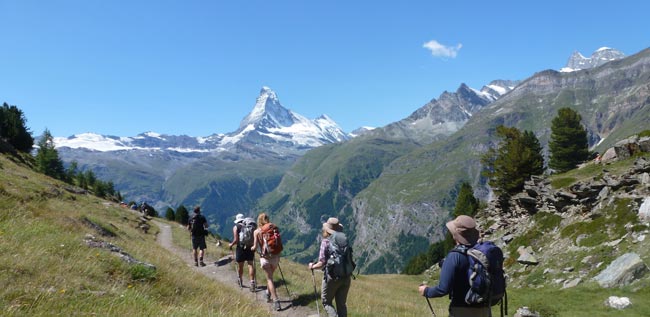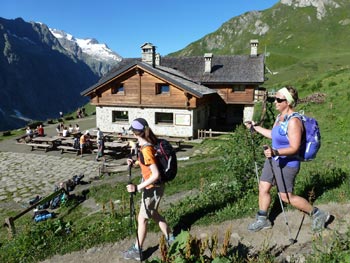
Are you fed up with damp British summers?
My first experience of hillwalking in the UK was at the age of 15 undertaking the ‘Pennine Way’. We set off with a large rucksack with enough to keep us self sufficient in the hills – tent, stove, waterproofs and most importantly midge repellent! We had a great adventure, but I have vivid memories of getting very wet and cold (and this was July!).
In those days, it wasn’t so easy to hop on a cheap flight to Europe, but now there’s no excuse! The summer weather in the Alps tends to be rather more reliable than it is here, and after you have factored in the comparative costs (return flights for under £100) then driving from Southern England to, say, the Lake District or Scotland seems expensive and fraught with congestion.
An obvious destination hub for Alpine walking trips is Geneva Airport. It has great transport links to Switzerland, France and Italy. There are also many minibus transfer companies that operate from there with very competitive rates (Chamonix transfer from £30). Geneva has lots of incoming flights from all over the UK so it’s feasible to do a long weekend.
The internet provides a wealth of information on walks in all the alpine regions and most French, Swiss and Italian maps can be ordered online in the UK. Swiss maps are excellent, French are pretty good and Italian maps are like Alfa Romeo cars, they look good but can be unreliable!
Walking on alpine trails is usually a drier and warmer experience than in the UK, although afternoon thunderstorms can bring a deluge. From a navigational point of view, the Alps could be seen as ‘easier’ due to most popular paths being paint marked and signposted, informing you of distances, the altitude and times to various places along the way. Having said that, don’t underestimate the possibility of being ‘navigationally challenged’! It’s still easy to get confused in some places, even on a sunny day, so you will still need to know how to use a map and compass. Above the tree line, and when the cloud drops, the path junctions may not be obvious, it’s possible to lose the trail on glacial moraine and miss path junctions, so keep a careful eye on the paint spots and still keep a check on your map. Early in the season you may have to cross some snow remnants from the winter, especially up high on north-facing slopes – so some skills in dealing with snow and ice might be necessary. Bear in mind a cold snap up high can bring snow any time of the year in the Alps. Some trails could have fixed cables and ladders on steep/ exposed sections – so make sure you’re not hanging onto them in a thunderstorm!
Altitude will slow you down so don’t push it on the first day. Some walking trails go above 3000m so a day’s acclimatisation would be advisable. If you do have any medical issues or accidents then helicopter rescue is available across the Alps but it will cost so make sure you have rescue insurance. Your EHIC UK medical card covers you across Europe (including Switzerland). The equipment needed will depend on the trail and how long you are away from civilisation.
 One of the highlights for many hikers is the chance to stay in the mountain huts ‘refuges’. There is an amazing network of alpine huts, allowing long walks to be undertaken with relatively lightweight rucksacks. Huts during the summer months are mostly manned so phone up/book your bed (best in advance especially in groups) and the hut ‘guardian’ will provide you with a hearty 3 course meal, breakfast and packed lunch if needed – there is even beer and wine! They also make good lunch stops too. Accommodation is normally in large, mixed, non-segregated dormitories. However in recent years many huts have had a makeover and may offer twin, double or quad rooms and even showers!
One of the highlights for many hikers is the chance to stay in the mountain huts ‘refuges’. There is an amazing network of alpine huts, allowing long walks to be undertaken with relatively lightweight rucksacks. Huts during the summer months are mostly manned so phone up/book your bed (best in advance especially in groups) and the hut ‘guardian’ will provide you with a hearty 3 course meal, breakfast and packed lunch if needed – there is even beer and wine! They also make good lunch stops too. Accommodation is normally in large, mixed, non-segregated dormitories. However in recent years many huts have had a makeover and may offer twin, double or quad rooms and even showers!
Lightweight waterproofs, trekking poles and sun cream (and ice axe if there’s a chance of snow) will be the main differences from your UK walking kit. Take plenty of water, although in most places you can refill our bottle from fountains or huts along the way. On shorter low level walks, you can get away with trekking shoes – on the higher walks, a good lightweight trekking boot is preferable. My top 10 kit recommendations are as follows, note there are women’s versions of most models.
1. Light 30l rucksack (Lowe-Alpine Airzone 32, Berghaus Remote 30, Montane Cobra 25)
2. Waterproof Jacket (Beghaus Civetta, Montane Direct Ascent, Marmot Spire)
3. Waterproof Trousers (Rab Bergen, Berghaus Vapour, Sprayway All Day)
4. Trekking Boots (North Ridge Corrie 2, Berghaus Explorer Light, Scarpa Cyclone)
5. Trekking Poles – here is my comprehensive article on Trekking Poles
6. Water Bottle (Hi Gear Polycarbonate 1L, Platipus 1L)
7. Synthetic Duvet (Montane Prism, Lowe-Alpine Glacier Point, Rab Xenon)
8. Soft shell (North Ridge Spindrift, Berghaus Breton, Rab Exodus)
9. Trekking Trousers (Rab Capstone, Berghaus Lonscale zip-off, Montane Terra)
10. Automatic Rescue Beacon – Echo112 is an automatic rescue beacon for your smart phone
The top multi-day Alpine walks are:
Tour of the MonteRosa
One of the finest and most challenging long distance walks in the Alps is to make a circuit of Monte Rosa. Lying in the Pennine Alps bordering Switzerland and Italy, the Monte Rosa massif is made up of seven summits over 4000 metres high, including the Dufourspitze, the second highest peak in the Alps. Still a relatively new circuit the Tour de Monte Rosa looks set to become one of Europe’s classic long distance walks: travelling on ancient paths, through pine forests, meadows and hidden valleys, with unparalleled views of the Matterhorn, the Weisshorn and the Dom.
Tour of Mont Blanc
The Tour du Mont Blanc is one of Europe’s classic long distance Alpine treks, or Grandes Randonnees – a complete circuit of Mont Blanc the highest mountain in Western Europe while passing through three countries and offering three cultures in France, Switzerland and Italy.
Tour of the Grand Paradiso
The very name conjures up images of a paradise among the high meadows and snow covered peaks and that pretty much sums up this trip. Six days traversing the Gran Paradiso National Park following a route which takes you close to the glaciers, past the green waters of the high lakes, and through a countryside rich in flowers.
Haute Route
Another of the ‘must do’ routes in the Alps, linking two of the most famous mountain towns in the world. You begin in Chamonix, France with views of Mont Blanc, and end in Zermatt in Switzerland, home of the Matterhorn.
Weekend hits and mini breaks include:
Tour Des Fiz
An ideal mountain weekend, passing through two nature reserves, providing you with a true alpine experience. The Rochers des Fiz is a massive rocky mountain ridge which dominates the skyline for miles around.
Mont Blanc Highlights
At the heart of the European Alps, the Chamonix valley in France is an ideal base from which to explore a range of beautiful walks. It is an area rich in mountaineering history and culture.
Zermatt Highlights
A picture postcard location for some great day walks and easy trekking peaks.
Eiger Highlights
Grindelwald is the valley base with a myriad of well signposted walks taking you below the majestic North Face of the Eiger.
Low trails are usually passable from early June, but for heights of 2500m leave it a little later, end of June – mid July (which is also the prime time for alpine flowers!) until late September and this is also when the huts open. Bear in mind that continental holidays make the end of July and beginning of August very busy. So for the best chance of catching the wildlife, my advice for peace on the trails is early to mid July and late August to early September.
If you are an adventurous walking DIY’er then any of these trips can be planned from the UK using online resources and maps. Or to make the most out of your trip consider an organised trip. Paying an operator to book your hotels, transfer bags and guide you to the perfect lunchtime meadows, tell you about the region and take you to the best coffee-and-tart stops is, I think, the way to go.
Based in Chamonix, British walking experts Tracks & Trails (020 8144 6442, www.tracks-and-trails.com) have many summer walking trips on offer – either join a group or go privately. It’s worth noting all walking guides in Europe must hold the IML (International Mountain Leader) qualification, this is the law in most countries and your insurance might not cover you if they aren’t. A half way house is a self guided trip, which organises all the logistics and itineraries, but you have to read the maps and do the work on the hill – for this we suggest www.alpineexploratory.com to facilitate these trips.
So next time you’re staring at the driving rain on your window and thinking of sun, views and mountains, then get on the net, book a flight, boat or train and head to the Alps. Next month’s instalment will take you off the trails and onto alpine glaciers for some ‘Glacier Trekking’.
Olly Allen
